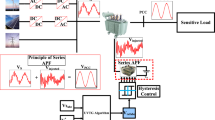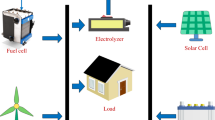Abstract
The penetration of renewable energy sources (RES) has been increased throughout the world. The main characteristic of RESs is that their generating powers are intermittent and unpredictable. This paper presents an interval optimization method to optimally schedule electric vehicles (EV) with considering the uncertainty of RES generation and loads. For this purpose, the RES generation (including photovoltaic and wind power) and loads are considered as interval parameters, and the charging/discharging power of EV is expressed as an interval variable to be optimally computed. The capability of RES inverters to regulate voltages is also considered in the interval optimization model. The objective function is to minimize the network active power losses and total voltage magnitude deviation with considering overall system constraints. The proposed method is tested on a 33-bus distribution system with uncertain RESs and loads, and the optimal day-ahead scheduling of EV is performed. Different case studies are carried out to test the effectiveness of the proposed method. It is demonstrated that the proposed interval optimization method can accurately represent the uncertain problem, and it provides further information compared with the deterministic optimization.











Similar content being viewed by others
References
Mathiesen BV, Lund H, Connolly D et al (2015) Smart Energy Systems for coherent 100% renewable energy and transport solutions. Appl Energy 145:139–154. doi:10.1016/j.apenergy.2015.01.075
Wright M, Hearps P (2010) Zero carbon Australia stationary energy plan. University of Melbourne Energy Research Institute, Melbourne, pp 1–171
Elliston B, Diesendorf M, Macgill I (2012) Simulations of scenarios with 100% renewable electricity in the Australian National Electricity Market. Energy Policy 45:606–6013
Mahmud N, Zahedi A (2016) Review of control strategies for voltage regulation of the smart distribution network with high penetration of renewable distributed generation. Renew Sustain Energy Rev 64:582–595. doi:10.1016/j.rser.2016.06.030
Zhang Y, Gatsis N, Giannakis GB (2012) Robust distributed energy management for microgrids with renewables. In: International conference on smart grid communications, pp 510–515. doi:10.1109/SmartGridComm.2012.6486036
Mahmoud K, Yorino N, Ahmed A (2016) Optimal distributed generation allocation in distribution systems for loss minimization. IEEE Trans Power Syst 31:960–969. doi:10.1109/TPWRS.2015.2418333
Mahmoud K, Abdel-Akher M, Ahmed A-FA (2010) Sizing and locating distributed generations for losses minimization and voltage stability improvement. In: 2010 IEEE international conference on power energy. IEEE, pp 600–604
Agalgaonkar YP, Pal BC, Jabr RA (2015) Stochastic distribution system operation considering voltage regulation risks in the presence of PV generation. IEEE Trans Sustain Energy 6:1315–1324. doi:10.1109/TSTE.2015.2433794
Liang R-H, Chen Y-K, Chen Y-T (2011) Volt/Var control in a distribution system by a fuzzy optimization approach. Int J Electr Power Energy Syst 33:278–287. doi:10.1016/j.ijepes.2010.08.023
Ziadi Z, Oshiro M, Senjyu T et al (2014) Optimal voltage control using inverters interfaced with PV systems considering forecast error in a distribution system. IEEE Trans Sustain Energy 5:682–690. doi:10.1109/TSTE.2013.2292598
Ma Y, Houghton T, Cruden A, Infield D (2012) Modeling the benefits of vehicle-to-grid technology to a power system. IEEE Trans Power Syst 27:1012–1020. doi:10.1109/TPWRS.2011.2178043
Falahi M, Chou H, Member S et al (2013) Potential power quality bene fi ts of electric vehicles. IEEE Trans Sustain Energy 4:1016–1023
Briones A, Francfort J, Heitmann P et al (2012) Vehicle-to-grid (V2G) power flow regulations and building codes review by the AVTA. Idaho National Laboratory, Idaho Falls
Odun-Ayo T, Crow M (2009) An analysis of the impact of plug-in hybrid electric vehicles on power system stability. In: 41st orth American power symposium. IEEE, pp 1–5
Wang J, Liu C, Ton D et al (2011) Impact of plug-in hybrid electric vehicles on power systems with demand response and wind power. Energy Policy 39:4016–4021. doi:10.1016/j.enpol.2011.01.042
Han S, Han S, Sezaki K (2010) Development of an optimal vehicle-to-grid aggregator for frequency regulation. IEEE Trans Smart Grid 1:65–72. doi:10.1109/TSG.2010.2045163
Abdel-Akher M, Eid A, Ali A (2017) Effective demand side scheme for PHEVs operation considering voltage stability of power distribution systems. Int J Emerg Electr Power Syst. doi:10.1515/ijeeps-2016-0041
Sovacool BK, Hirsh RF (2009) Beyond batteries: an examination of the benefits and barriers to plug-in hybrid electric vehicles (PHEVs) and a vehicle-to-grid (V2G) transition. Energy Policy 37:1095–1103. doi:10.1016/j.enpol.2008.10.005
Liu L, Kong F, Liu X et al (2015) A review on electric vehicles interacting with renewable energy in smart grid. Renew Sustain Energy Rev 51:648–661. doi:10.1016/j.rser.2015.06.036
Shafiee S, Fotuhi-Firuzabad M, Rastegar M (2013) Investigating the impacts of plug-in hybrid electric vehicles on power distribution systems. IEEE Trans Smart Grid 4:1351–1360. doi:10.1109/TSG.2013.2251483
Abdelfatah A, Raisz D (2016) Optimal charging/discharging of PHEVs for predictability enhancement of wind power generation. Period Polytech Electr Eng 60:261–265. doi:10.3311/PPee.10019
Aghaei J, Nezhad AE, Rabiee A, Rahimi E (2016) Contribution of plug-in hybrid electric vehicles in power system uncertainty management. Renew Sustain Energy Rev 59:450–458. doi:10.1016/j.rser.2015.12.207
Yang Z, Li K, Foley A (2015) Computational scheduling methods for integrating plug-in electric vehicles with power systems: a review. Renew Sustain Energy Rev 51:396–416. doi:10.1016/j.rser.2015.06.007
Yilmaz M, Krein PT (2013) Review of the impact of vehicle-to-grid technologies on distribution systems and utility interfaces. IEEE Trans Power Electron 28:5673–5689. doi:10.1109/TPEL.2012.2227500
Kelly L (2009) Probabilistic modelling of plug-in hybrid electric vehicle impacts on distribution networks in British Columbia. Master’s thesis, University of Waterloo, Waterloo, ON, Canada
Zhao J, Wan C, Xu Z, Wang J (2015) Risk-based day-ahead scheduling of electric vehicle aggregator using information gap decision theory. IEEE Trans Smart Grid. doi:10.1109/TSG.2015.2494371
Wang Y, Xia Q, Kang C (2011) Unit commitment with volatile node injections by using interval optimization. IEEE Trans Power Syst 26:1705–1713. doi:10.1109/TPWRS.2010.2100050
Bai L, Li F, Cui H et al (2016) Interval optimization based operating strategy for gas–electricity integrated energy systems considering demand response and wind uncertainty. Appl Energy 167:270–279. doi:10.1016/j.apenergy.2015.10.119
Walpita LM, Mathis RF (1986) Interval arithmetic in power flow analysis. IEEE Trans Power Syst 1:1009–1011. doi:10.1107/S1600536810018519
Chen C, Wang F, Zhou B et al (2015) An interval optimization based day-ahead scheduling scheme for renewable energy management in smart distribution systems. Energy Convers Manag 106:584–596. doi:10.1016/j.enconman.2015.10.014
Baimel D, Tapuchi S, Baimel N (2016) Smart grid communication technologies. J Power Energy Eng 4:1–8. doi:10.4236/jpee.2016.48001
Moeini-Aghtaie M, Abbaspour A, Fotuhi-Firuzabad M, Dehghanian P (2013) PHEVs centralized/decentralized charging control mechanisms: requirements and impacts. In: 2013 North American power symposium. IEEE, pp 1–6
Ma Z, Callaway DS, Hiskens IA (2013) Decentralized charging control of large populations of plug-in electric vehicles. IEEE Trans Control Syst Technol 21:67–78. doi:10.1109/TCST.2011.2174059
Moore RE (1979) Methods and applications of interval. Analysis. doi:10.1137/1.9781611970906
Sengupta A, Pal TK (2009) On comparing interval numbers: a study on existing ideas. Stud Fuzziness Soft Comput 238:25–37. doi:10.1007/978-3-540-89915-0_2
Baran AR, Fernandes TSP (2016) A three-phase optimal power flow applied to the planning of unbalanced distribution networks. Int J Electr Power Energy Syst 74:301–309. doi:10.1016/j.ijepes.2015.07.004
El-Bakry AS, Tapia RA, Tsuchiya T, Zhang AY (1996) On the formulation and theory of the Newton interior-point method for nonlinear programming 1. J Optim Theory Appl. doi:10.1007/BF02275347
Wright SJ (1997) Primal-dual interior-point methods. Society for Industrial and Applied Mathematics, Philadelphia
Baran ME, Wu FF (1989) Network reconfiguration in distribution systems for loss reduction and load balancing. IEEE Trans Power Deliv 4:1401–1407. doi:10.1109/61.25627
Australian Standard AS/NZS 61000.3.100:2011 (2011) Electromagnetic compatibility (EMC)—limits—steady state voltage limits in public electricity systems
Author information
Authors and Affiliations
Corresponding author
Rights and permissions
About this article
Cite this article
Ali, A., Raisz, D. & Mahmoud, K. Optimal scheduling of electric vehicles considering uncertain RES generation using interval optimization. Electr Eng 100, 1675–1687 (2018). https://doi.org/10.1007/s00202-017-0644-x
Received:
Accepted:
Published:
Issue Date:
DOI: https://doi.org/10.1007/s00202-017-0644-x




